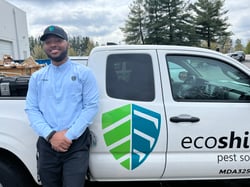Roughly 70% of households in the United States have a furry family member taking up residence. Whether it’s a cat, dog, or hamster, homeowners who are seeking pest solutions, homeowners must consider the safety of their pets. With chemical products readily available in the marketplace, finding the right solution for your whole family can be overwhelming. Luckily, there are professional pest control options that are considered pet friendly and when applied properly can keep your furry fam out of harm's way. But what does “pet friendly” really mean? And is it really safe for pets?
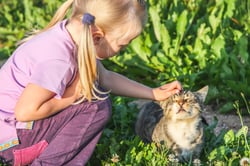
Why are some pest control options unsafe for pets?
To better understand what pet-friendly pest control entails, it’s important to know why some products and solutions could be unsafe for pets. It should be noted that the danger some solutions present is highly dependent on formulation, the species and size of the pet, and even the application method. For example, some ingredients may be more harmful to smaller pets but less so to larger breeds. That being said, some potentially unsafe solutions may include:
- Insecticides: Some insecticides may contain chemicals that can be toxic to pets. These may include pyrethroids, organophosphates, carbamates, and neonicotinoids. These chemicals can cause a wide range of symptoms in pets, such as vomiting, diarrhea, drooling, difficulty breathing, tremors, seizures, and even death.
- Rodenticides: Rodenticides are designed to kill rodents, but they can also pose a risk to pets if ingested. Rodenticides may contain anticoagulant or neurotoxic chemicals that can cause internal bleeding or neurological symptoms in pets.
- Snail and slug baits: These products are used to control snails and slugs in gardens, but they can be harmful to pets if ingested. They often contain metaldehyde, which can cause symptoms such as tremors, seizures, and even death in pets.
- Mole or gopher baits: These products are used to control moles or gophers in lawns and gardens, but they can be toxic to pets if ingested. Mole or gopher baits may contain chemicals such as zinc phosphide or bromethalin, which can cause serious health issues in pets.
- Flea and tick products: Some flea and tick products that are designed for dogs can contain chemicals that are toxic to cats, and vice versa. It is important to use flea and tick products that are specifically formulated for your pet's species, size, and weight and to follow the instructions carefully.
- Fumigants: Fumigants are used to control pests in enclosed spaces, such as in homes or warehouses. These products release toxic gasses that can be harmful to pets if they are inhaled or ingested.
It is crucial to exercise caution and consult with professionals when using any pest control product in a home with pets. Always read and follow the label instructions, store the products securely out of reach of pets, and contact your veterinarian immediately if your pet shows any signs of illness after potential exposure to pest control products.
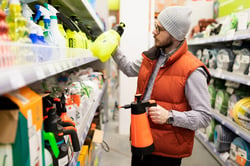 Many off-the-shelf retail products contain chemicals that can be dangerous for some pets.
Many off-the-shelf retail products contain chemicals that can be dangerous for some pets.
Is DIY pest control dangerous for pets?
The short answer is: it can be.
Generally, we highly discourage homeowners with pets from attempting DIY pest control. DIY solutions can often seem like the cheaper option, but they can become expensive quickly through multiple failed attempts, necessary re-treatments, and exacerbated pest problems due to ineffective treatment. More importantly, attempting pest control without experience or technical knowledge can be extremely dangerous to both people and pets. Some reasons why DIY pest control for pet owners may be harmful include:
- Lack of Knowledge and Experience: DIY pest control methods often involve using chemicals, traps, or baits to control pests. However, improper use of these products due to a lack of knowledge or experience can pose a risk to pets. For example, using the wrong type of product, applying it inappropriately, or using the wrong dosage can result in accidental exposure or ingestion by pets.
- Toxicity of Pest Control Products: Many pest control products contain chemicals that are toxic to pets. These chemicals are formulated to kill or control pests and they can cause a wide range of adverse effects in pets. These effects range from mild to severe, depending on the product type, the concentration of the active ingredient, and the size and species of the pet. Pets may accidentally ingest or come into contact with these products when they are applied or stored improperly, leading to potential toxicity.
- Inappropriate Product Selection: DIY pest control methods may involve selecting and using products that are not safe for pets without a proper understanding of their potential hazards. For example, some products that are intended for use in outdoor environments may not be safe for indoor use or for homes with pets, as they may have higher toxicity levels or be formulated with chemicals that are harmful to pets.
- Lack of Pet-Specific Considerations: DIY pest control methods may not take into account the unique needs and sensitivities of pets. For example, cats are more sensitive to certain chemicals than dogs, and some products that are safe for dogs may not be safe for cats. Additionally, pets that are elderly, pregnant, nursing, or have pre-existing health conditions may be more susceptible to the adverse effects of pest control products.
- Accidental Exposure: DIY pest control methods may involve placing traps, baits, or other products in areas where pets have access, increasing the risk of accidental exposure or ingestion. For example, pets may ingest bait stations or traps or come into contact with treated surfaces, leading to potential toxicity.
- Lack of Proper Application Techniques: Proper application techniques are important for ensuring the effectiveness and safety of pest control products. DIY pest control methods may not always involve using proper application techniques, such as wearing protective gear, following label instructions, or applying products in appropriate areas or concentrations, which can increase the risk of pet exposure.
It’s critical to remember that pets, particularly dogs and cats, can be much more sensitive to the effects of certain pest control products than humans. Even small amounts of exposure, inhalation, or ingestion can result in serious health problems. Please do not attempt DIY pest control in a home with pets, as you may unknowingly put them at risk. Consulting with a licensed pest control professional or a veterinarian can help ensure that appropriate pest control measures are taken in homes with pets.
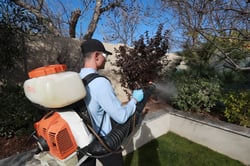 DIY attempts at pest control can be dangerous to people and pets without the proper equipment.
DIY attempts at pest control can be dangerous to people and pets without the proper equipment.
What is pet-friendly pest control?
Pet-friendly pest control refers to pest management practices that are intended to control pests while minimizing risks to pets. These methods prioritize the safety and well-being of pets and typically involve the use of products and techniques that are specifically formulated or applied in a manner that reduces the potential for harm to pets. Professional pest control companies that use pet-friendly products and practices may employ the following methods:
- Natural or “Green” Pest Control: The use of natural or plant-based pest control products that are derived from natural sources, such as plants, plant extracts, or even essential oils. These products are considered to be less toxic to pets compared to synthetic chemical pesticides. Examples of natural or plant-based pest control methods include the use of diatomaceous earth, neem oil, or vinegar-based solutions.
- Integrated Pest Management (IPM): IPM is a holistic approach to pest control that involves using a combination of techniques, such as biological controls (beneficial insects), cultural controls (sanitation practices), mechanical controls (traps), and chemical controls (pesticides), in a targeted and mindful manner to manage pests. IPM focuses on using the least toxic methods first and limiting the use of chemical pesticides while also considering the potential impacts on pets, wildlife, and the environment.
- Pet-Safe Formulations: The use of pest control products that are specifically formulated to be safe for pets. These products may have lower toxicity levels, shorter residual effects, or specific application instructions that minimize the risk of pet exposure. Examples include pet-safe insecticides, rodenticides, and baits that are labeled as safe for pets, and flea and tick products that are formulated for specific pet species and sizes.
- Proper Application Techniques: Ensuring that pest control products are applied in a manner that minimizes the risk of pet exposure. This may include applying products in areas that are inaccessible to pets, using appropriate dosages and concentrations as directed on the label, avoiding overspray or drift, and using proper protective gear during application.
- Prevention and Exclusion Methods: Implementing preventive measures, such as sealing entry points, removing food and water sources, and maintaining good hygiene practices, to reduce the need for chemical pest control methods and minimize risks to pets.
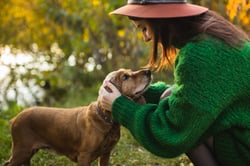
Is EcoShield Pest Solutions a pet-friendly pest control provider?
Yes!
At EcoShield, what’s important to you is important to us – including your pets! Our solutions and practices closely adhere to the aforementioned pet-friendly practices. EcoShield’s products, methods, and application techniques are all thoughtfully designed by pest experts to be effective and eco-friendly, with the goal of minimizing exposure for people, children, and pets. Our top priority is always the safety of you and your family… and that means furry ones, too.
Not only do we choose specific products that are effective with your health and happiness in mind, but our technicians are licensed and rigorously trained in the most effective application methods. We also strive to utilize botanical products and minimize pesticide usage when treating your home. Additionally, we do not use pesticides that contain neonicotinoids in any of our treatments.
All the materials we use at EcoShield are carefully regulated by the Environmental Protection Agency and the National Pest Management Association, and all of our technicians are state licensed and trained in applying all materials we use. At EcoShield, we always practice environmentally conscious pest control and apply all materials according to label instructions. We offer holistic solutions for homeowners that help to reduce the need for chemicals and will also help to relocate honeybees if they are a problem for homeowners. EcoShield keeps your furry friends in mind when creating pest treatment plans and utilizes locked bait boxes as an added precaution.
At EcoShield we also specialize in exclusion services that are designed to keep pests and rodents out of your home. We provide a free no-obligation inspection of your home and will develop a customized pest control solution that meets the needs of your family to keep your home pest-free.
Do you need pet-friendly pest control? Give EcoShield a call or fill out the form on this page today to receive your FREE no-obligation quote.
